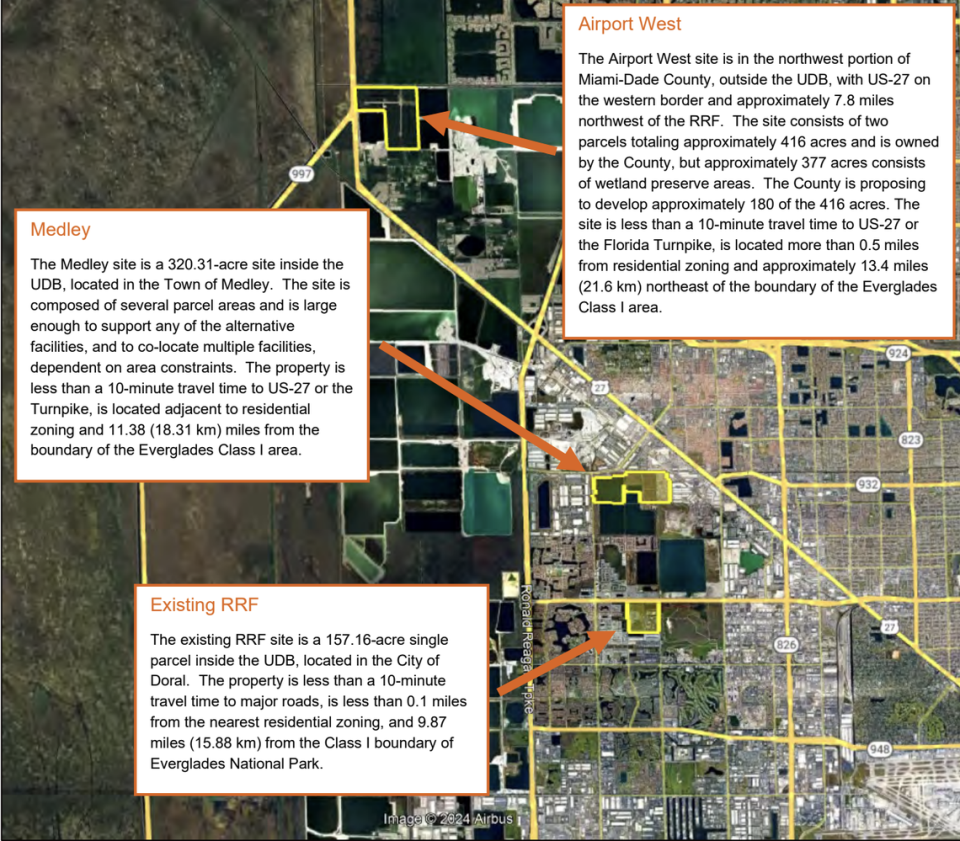Where will the next Miami-Dade incinerator go? Consultant report rates sites
Since Miami-Dade’s main waste incinerator burned down in Doral last year, tons of excess garbage have been shipped off via train to other counties, landfills are filling up and the difficult decision of where to build a new one still looms.
A new consultant’s report that analyzed three potential sites — at the original Doral location, at the defunct Opa-locka West Airport and in an industrial tract in Medley — will only add fuel to the fire of the ongoing debate. None of the residents in nearby communities want the $1.2 billion waste-to-energy incinerator, despite the fact that the new technology is reputedly greener, cleaner and far less smelly. Each site, the report found, had its pros and cons.
The consultants found some sites would be easier to build on than others. For example, the report said Medley could be a “complicated and challenging” site to get air permits from the U.S. Environmental Protection Agency for because it’s already near a landfill and a cement operation. It would also be the most expensive option. But the town mayor, unlike in other places, also supports locating it there, according to CBS-4, the Herald’s news partner.

Because the Opa-locka site, called Airport West in the report, is in a less developed area, the report suggested it might be easier to get a permit from the EPA. But the city of Miramar is campaigning against that location, even putting a petition on the city website.
During Tuesday’s county commission meeting, Miramar Mayor, Wayne Messam, said they were prepared to file a lawsuit if the Airport West site was chosen.
“We maintain the strongest objections from the airport west site. It’s bad for the environment, bad for the public,” Messam said at the podium.
Keeping the incinerator in its original Doral site would be the cheapest and quickest option, the report found. There’s already some existing infrastructure and it has been approved as an energy facility since the 1980s.
But there also has been major political push-back. The city of Doral has made clear it doesn’t want another waste-to-energy trash-burning facility being built within their boundaries. Doral is so serious about getting the incinerator out of its city that it is in talks with the county to help fund the relocation of the new incinerator, which would process 4,000 tons of trash a day.
“We’ve had the waste-to-energy facility in our backyard for over 40 years,” Doral Councilwoman Maureen Porras said. “I think this is a burden that the city of Doral has had to deal with for a very long time.”
“It doesn’t belong in the city of Doral where it’s next to so many homes and residences,” Porras added.
Porras said she’d prefer the county to put the incinerator at the most remote option, Airport West, which Mayor Danielle Levine Cava originally proposed as her first choice after the fire burned the Doral site. The Airport West site sits outside the Urban Development Boundary that Levine Cava has fought to uphold throughout her time in office.
All three sites also are within 15 miles of Everglades marshes, which might mean a longer and more complicated permitting process from federal agencies. The Doral site is actually the closest to Everglades National Park.
The report found that no matter where the incinerator was built, it would have little to no impact on human health or the surrounding environment. The safest for human health is the Airport West site.
“The worst-case health effects level at three sites is below the risk posed by simply walking down the street and inhaling,” the memo read.
The report said the new incinerator would have similar air pollution controls and emissions as the Covanta facility in West Palm Beach that’s been up and running since 2015 — a marked improvement from the aging Doral facility.
Some activists in the area, including Earth Justice and Florida Rising, want to get rid of the incinerator altogether. They’d like the county to move towards a zero waste system by composting, recycling and reusing garbage — not setting it on fire.
However, Miami-Dade’s climate action plan mentions a trash incinerator as a major step in the county’s goal of ending the use of fossil fuels. The county would one day like to use energy produced by the plant to fuel its garbage trucks, the plan says.
The county is making sure to approach this process “as methodically as possible, thorough evaluation of all possible sites, information-sharing and input from key stakeholders across the community,” said chief operations officer Jimmy Morales in a statement to the Herald.
The next step is to conduct community outreach - including the impacted cities, communities, and organizations up until recommending a site at the Sep. 4 commission meeting.
Ashley Miznazi is a climate change reporter for the Miami Herald funded by the Lynn and Louis Wolfson II Family Foundation in partnership with Journalism Funding Partners.


